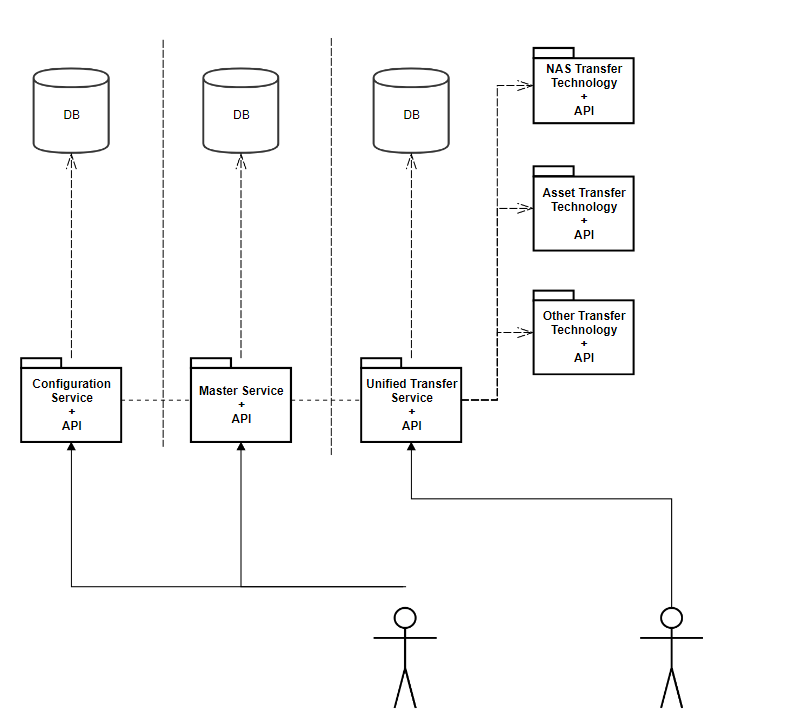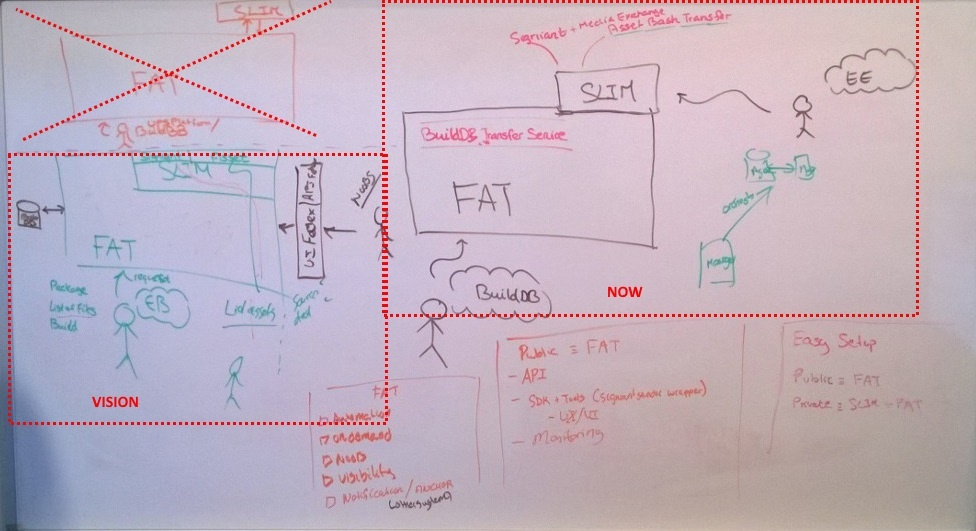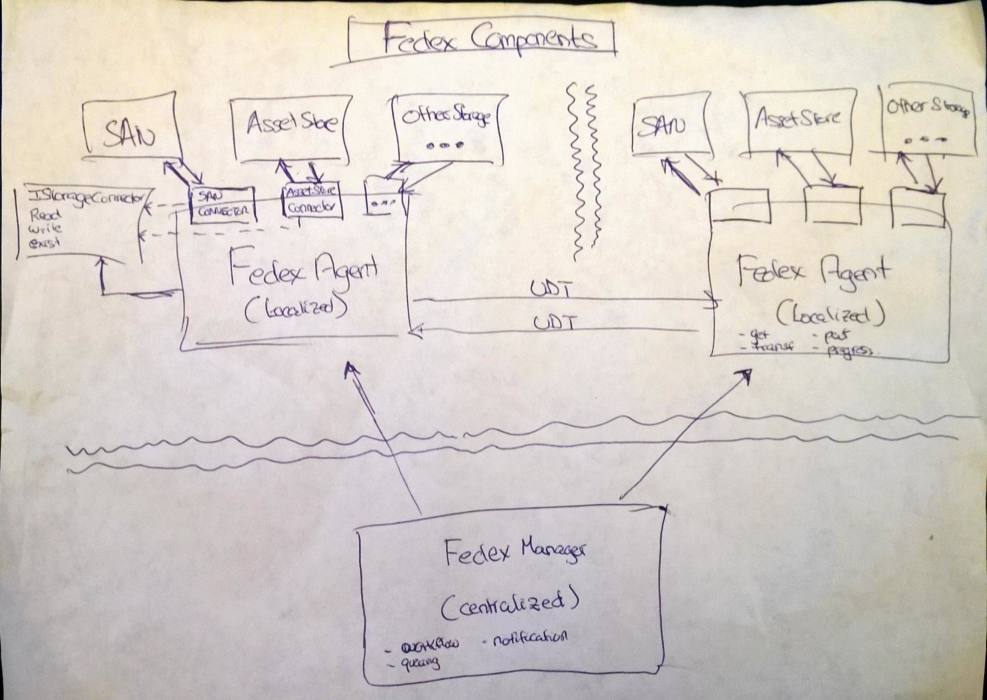Ups Vision Meeting Notes
The final goal of this set of meetings is to establish a clear vision of our solutions in order to present a homogeneous image of our direction towards ourselves and our clients in terms of future development for the productions.
Date
17 Nov 2015
Attendees
- Jonathan Chin
- Laurent Chouinard
- Alexandre Fournier
- Simon Poliquin
Goals
- Establish the scope of these meetings
Discussion items
Scope
- Two majors aspects
- What is the vision?
- How to achieve that vision?
What
- Service grouping
- Collect the technologies and services that make sense together and present them as a common facade
- Mastering: Hide, BuildDB Agent, DigiSign, BurningCenter
- Distribution: Tunnel, Asset Store, Symbol Store, Storage Service, Streamers, WarpGate and other clients
- Administration: Operations (slice + global) & productions (slice)
- Slice: Administrate their slice of the service such as adding users
- Global: Administrate the service as a global entity such as deployment
- Naming
- The names needs to be engaging
How
- Some questions were identified regarding our products and services
- What are the use cases?
- What are the boundaries and responsibilities?
- What is the language/glossary for communication?
Who
- Who else should be involved?
- Depending on the products and services, experts can be added to the meeting.
Date
24 Nov 2015
Attendees
- Jonathan Chin
- Laurent Chouinard
- Alexandre Fournier
- Simon Poliquin
Goals
- Discuss the previous meeting
- Any addendum?
- Any reservation?
- Any improvements?
- Discuss the “grand scheme of things”
- Discuss the vision for a narrow slice of the “grand scheme of things”
- Discuss the branding
Discussion items
Previous Meeting
- We agree on what was discuss in the previous meeting
- Service grouping into logical unit makes sense
Grand Scheme of Things
- Our offering needs to move away from BuildDB in order to be more generic
- Anyone should be able to use a slice of our technological offering without an impression of heaviness
- Present targeted API/SDK
- Perceived as modular
- For example, if someone wants to transfer a set of files but doesn’t want to use BuildDB, it should be allowed
- Our system can create a build in BuildDB if needed but it is transparent to the user
- Streamlined usage
- Each use case needs easy access
- UPS artifacts (build db xml) should stay inside UPS
- Configuration (how a transfer link to a build) should stay inside UPS
- Present targeted API/SDK
Narrow Slice

- Slice by use case / business case / service offer
- Individual slice can be accessed via API by anyone or via an optional gateway
- A gateway is practically a 1 to 1 forward call to the API
- Useful when you want to provide the service accessible to people with no to little experience in web
- The “synergized” set of service is implicit in the each service offer
- For example,
- User tell Transfer API to transfer build id 123
- Transfer API takes care of it
Branding
Date
15 Dec 2015
Attendees
- Jonathan Chin
- Laurent Chouinard
- Alexandre Fournier
- Simon Poliquin
Goals
-
Discuss the previous meetings
-
Discuss strategies on getting to the destination
Discussion items
Previous Meetings
- We agree that the first axis remains the Unified Transfer Service / Fedex
- The question of whether we need or should have a gateway is non essential
- A gateway can be added at little to no costs since it provide nothing more than forward calling and a common view on APIs
Opportunities
- Development needs to be aligned with opportunities
- Symbol Store
- The CREW needs to be able to clean and copy a cluster to another cluster
- Components of this Fedex such as the Asset Transfer Technology + API can be built independently for this need
- This would be the first stepping stone towards the endgame
- Co-dev among the Asset Store and the BuildDB team should be favored
Strategies
- We identify two distinct flavored on how to get there with lots of similarities but distinctive details

- In step 1, we refactor in CORE and in the DB, specifics for Asset Transfer and Signiant Transfer
- Hence, we make it generic to handle file transfer and asset transfer by breaking depedencies
- Note that in the Transfer service, we don’t have any notion of file transfer or asset transfer. There is only a notion of build transfer
- All transfers should be grouped into package (keep it how it is and find a concensus on how to handle it)
- Maybe we can create here something that handle concept that is not build
- In step 2, we spin off the Transfer service into its own project/solution
- We add specifics for asset transfer and file transfer while keeping the build transfer (build are package)
- Asset transfer and file transfer create package in the background
- In step 3, we spin off the transfer from the core
- Assets transfers and file transfers create package to transfer
- In step 4, we spin off the transfer from the database
- We now have an independent transfer system
- Future development can include
- Plugging the signiantsender into it and remove signiant transfer service
TODO
- Epic or features based
- Symbol transfers
- Include the backend of independent asset transfers? (not mandatory)
- front end that combines step 1 and 2
- list of symbols attached to manifest
- Symbol without a build
- creates a package (should be step 3)
- Sound transfers
- Symbol transfers
Date
10 Feb 2016
Attendees
- Jonathan Chin
- Laurent Chouinard
- Alexandre Fournier
- Simon Poliquin
Goals
- How to get
Discussion items
Previous Meeting
- During the previous, we try to establish a road map on how the development should take place.
- It has proven to be a bit more difficult to establish such steps.
- Perhaps, we should focus on what we have now, on our endgame and aligned the development with business opportunities.
Opportunities
- Standalone Assets Transfers
- Symbol Transfers
- Sound Transfers
- Clusters to Clusters Transfers
Current Architecture
- The following diagram represents what we have now.

Architecture Change
- The following diagram represents our architecture as far as the transfer service is concerned by considering the business opportunities
- The left represents what would BuildDB looks like when we slice off the standalone transfer service, which is on the right
- The standalone transfer service can
- transfers a collection of files
- transfers a collection of assets
- transfers a package that is composed of files and/or assets
- queues transfers
- The BuildDB Core will be responsible BuildDB logic
- Identify the right studio (not the right agents or node, this is the other guy)
- Notification for agents and cachers
- Inject BuildDB information into the transfer like the path change

- There should be no transfer logic in BuildDB since it should only use it as a black box
- You could have an endpoint that allows the transfer of a build but it will be forwarded to Transfer Service
Epics
- Merge BuildDB Transfer (relevant part) and Signiant Transfer Service into Transfer Service
- The only call to Transfer Service should be transfer this list of files and/or assets, let me know when it’s done
- Asset Store API includes transfer mechanism
Open Questions
- REST / Resource Based API versus SOAP / Action Based API
Date
16 Mar 2016
Attendees
- Jonathan Chin
- Laurent Chouinard
- Alexandre Fournier
- Simon Poliquin
Goals
- Compare and contrast the FAT and SLIM approach
Discussion items
SLIM
- SLIM is devoided of all business logics
- It receives instructions and simply executes the instructions
- If a transfer of a certain entity needs to place things in a certain order, the SLIM will need to receive such instructions
FAT
- FAT contains all business logics related to transfers of entities
- If a transfer of a certain entity needs to place things in a certain order, the FAT will orchestrate all the necessary
SLIM versus FAT
- SLIM is the technological aspect of the transfer
- FAT is the business aspect of the transfer
SLIM and FAT
- SLIM and FAT are not mutually exclusive
- Often, FAT is composed of multiple SLIM subsystem
- What is different is whether users can access the SLIM system by itself or not
Business Vision of SLIM and FAT
- SLIM is a subsystem of FAT
- All clients’ access is through the FAT
- If clients don’t need the FAT, they will still access the FAT but the calls can be forwarded internally to SLIM
- It will be simply another path in FAT

Date
21 Mar 2016
Attendees
- Jonathan Chin
- Laurent Chouinard
- Alexandre Fournier
- Simon Poliquin
Goals
- Define the business use cases for the service
Discussion items
Business Use Case Definition

Date
22 Mar 2016
Attendees
- Jonathan Chin
- Alexandre Fournier
- Simon Poliquin
Goals
- Link the Business Cases to Features
Discussion items
Linking to Features

Features
P1: On Demand Package Transfers
- API
- Application
P3: Dropbox / Live Replication
- Setup via Application
P3: Peer to Peer Package Transfers (ala Media Exchange to Internal and External)
- API
- Application
High Level Architecture
Database
- The system will have its own database
- It will store the information related to the transfers
- It will contains soft keys to other database when needed
Technology Services
- The technology services are slim / dumb services that receive and execute instructions for transfers
- It is devoided of any business logic that is not related to the actual transfers
- Basically, it is like a CRUD
- There could be 1 services per storage technology. For instance,
- Transferring files located on a SAN or Windows Share will be done via Signiant
- Transferring files located on an Asset Store will be done via Asset Replicate (or the new Independent Asset Transfer System)
Business Services
- This box contains the business logics related to transfers and the orchestration of such transfers
- Basically, using the provided CRUD, it does magic
- The business logics would be common to all types of transfers although certain particularities can be different
- For example, security would encompass any type of transfers whether it is signiant transfer or asset replicate
- Another example would be queuing.
Clients
- Clients can initiate transfer through multiple entry points: API, Application (Mainframe, SigniantSender, etc.)
- When using the API, clients are responsible for creating a package for the transfer
- When using the applications, the latter will handle the creation of the package for the transfer
- A package is defined as a package in the ecosystem of UPS.
- For instance, the package in the current ecosystem of UPS would be a Build because of BuildDB
- Technology Services are hidden behind the Business Services
- If we need to update the technology services, it will be protected by the business services



Leave a Comment
Your email address will not be published. Required fields are marked *